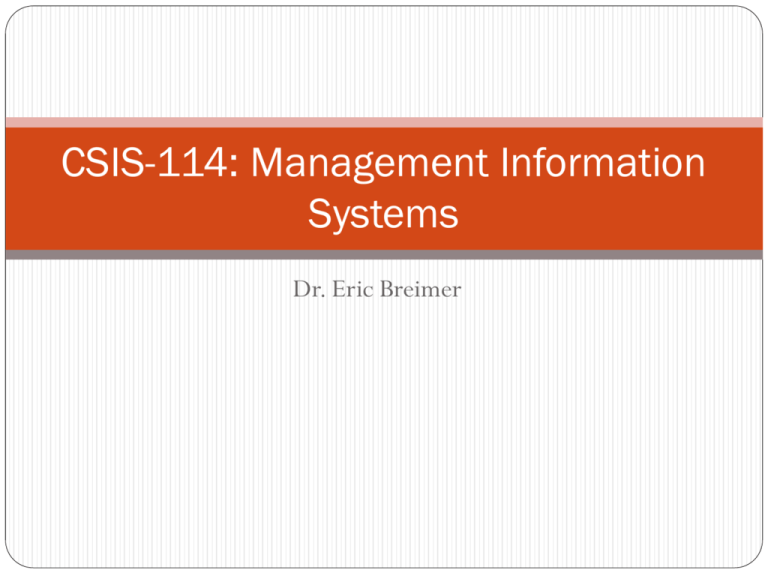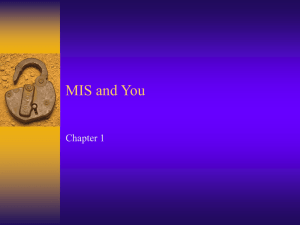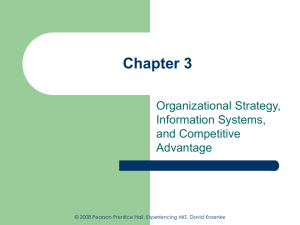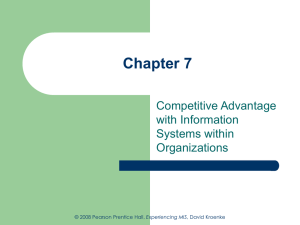
CSIS-114: Management Information
Systems
Dr. Eric Breimer
Syllabus
Google “Eric Breimer”
Click on CSIS-114 link
Click on Syllabus link
The Big Questions
What is MIS?
What should you learn from this class?
How can you enjoy this class?
What is MIS
MIS—management information systems—is the
development and use of information systems that help
businesses achieve their goals and objectives
Three key elements:
Components of information systems
Development and use of information systems
Achieving business goals and objectives
What is MIS
Information Systems components
Hardware – desktops, laptops, PDAs
Software – operating systems, application programs
Data – facts and figures entered into computers
Procedures – how the other four components are used
People – users, technologists, IS support
Development and Use of
Information Systems
You might
Specify the requirements of an information systems
Manage development projects that use information systems and
technology
You must
Use information systems effectively and responsibly.
The Core Purpose of all
Management information systems
Helps a business achieve goals and objectives
Increase sales / grow the business
Increase efficiency / cut costs
Make more money
Gain a competitive advantage
How Can You Enjoy This Class?
Think about the information systems around you and how
they interact with each other. How do they affect your life
and your job.
Every day you touch dozens of information systems.
Does the information provided make a difference?
Do the systems and information impact your personal life and
your job?
© Pearson Prentice Hall
2009
Functional Areas
Early information system were designed to help business in
key functional areas.
Accounting (Transaction Management)
Finance (Investment Management)
Marketing (Advertizing and Sales Management)
Human Resources (People Management)
Operations (Production Management)
Important questions
What is the five-component framework and why is it
important?
What is information?
What are the characteristics of good information?
What is the difference between information technology and
information systems?
1-10
Five-Component Framework?
Five components interact with each other to create a
complete information system
Why is this important
In a business you are part of the information system
Most people think of IS as hardware and software only
Data, Procedures and People are the more crucial components
1-11
© Pearson Prentice Hall
2009
Actors, Instructions & Bridges
Actors – hardware and people take actions
Instructions – software and procedures provide instructions for
actors
Bridges – data bridges hardware/software and
people/procedures
1-12
Automation & Resistance to Change
High Tech vs. Low Tech
Low tech – using an email program
just a small amount of work is being accomplished by a
computer system.
High tech – implementing a customer support system
large amount of work is being accomplished by the computer
system rather than humans.
How Can You Use the
Five-Component Framework?
After this class, you’ll look at an information system and
evaluate each component separately and then as a whole
system.
Hardware is often the easiest component to identify and
evaluate
Identifying and evaluating the role of the people can be tricky,
but leads to a great understanding.
ITunes
The business
The goal
The five components
1-16
© Pearson Prentice Hall
2009
What is Information?
before we really talk about Information Systems…
Information is:
Knowledge derived from data.
Data presented in a meaningful context.
Data processed by summing, ordering, averaging, grouping,
comparing, or other similar operations.
A difference that makes a difference.
Data
(input)
Processing
Information
(output)
Data vs. Information
Data
raw facts
no context
just numbers and text
Information
data with context
processed data
value-added to data
summarized
organized
analyzed
Data vs. Information
Data: 51009
Information:
5/10/09
$51,009
51009 Zip Code of Gary Indiana
Data vs. Information
Data
Information
6.34
SIRIUS SATELLITE RADIO INC.
6.45
$7.20
6.62
$7.00
6.57
$6.80
6.64
6.71
6.82
7.12
7.06
Stock Price
6.39
$6.60
$6.40
$6.20
$6.00
$5.80
1
2
3
4
5
6
Last 10 Days
7
8
9
10
Data Information Knowledge
Data
Summarizing the data
Averaging the data
Selecting part of the data
Graphing the data
Adding context
Adding value
Information
Data Information Knowledge
Information
How is the info tied to outcomes?
Are there any patterns in the info?
What info is relevant to the problem?
How does this info effect the system?
What is the best way to use the info?
How can we add more value to the info?
Knowledge
What is Information?
Information vs. Data is Subjective
What some people consider information, others think of as
raw data.
Context changes occur in information systems when
the output of one system is input to another system
1-23
What is Information?
Information is Subjective
Data in a manufacturing system may be very important to that
system. When it’s combined with data from other systems, it
may lose its prominence in the larger context.
Sales IS
Financial IS
Manufacturing IS
1-24
One User’s Information is Another
User’s Data
1-25
Characteristics of Good Information?
Accurate – entering incorrect sales data creates false information.
Timely – knowing that production doesn’t have enough raw materials
for next week’s schedule won’t be useful information three weeks from
now.
Relevant – if your boss needs to know how many shipments were late
last month, you shouldn’t give him a list of all items that shipped.
Worth its cost – is it cost worthy to map out the entire U.S. if you
only need one state?
These are just a few characteristics that are important...
1-26
Information Technology vs. Information Systems?
Because many people confuse the two terms, compare what each one
consists of and how the two differ.
Information technology pertains to
New Products
New Methods
Inventions
Standards
Information Systems include five
components
Hardware
Software
Data
Procedures
People
Information technology drives the development of new information
systems.
1-27
Information Technology vs. Information
Systems?
Moore’s Law
“The number of transistors per square inch on an integrated
chip doubles every 18 months.”
Dramatic Reduction in Price/Performance Ratio
Ratio fallen dramatically for over 40 years and is estimated to
continue to fall in accordance with Moore’s Law.
Enabled developments such as:
Laser printers, Graphical user interfaces, High-speed
communications, Cell phones, PDAs, Email, Internet
1-28
Information Technology vs. Information Systems?
1-29









